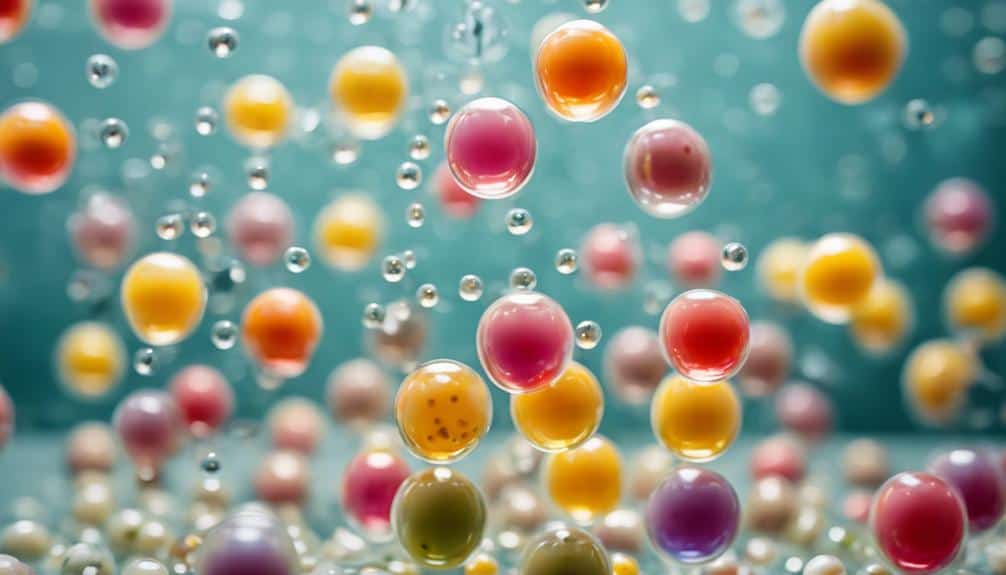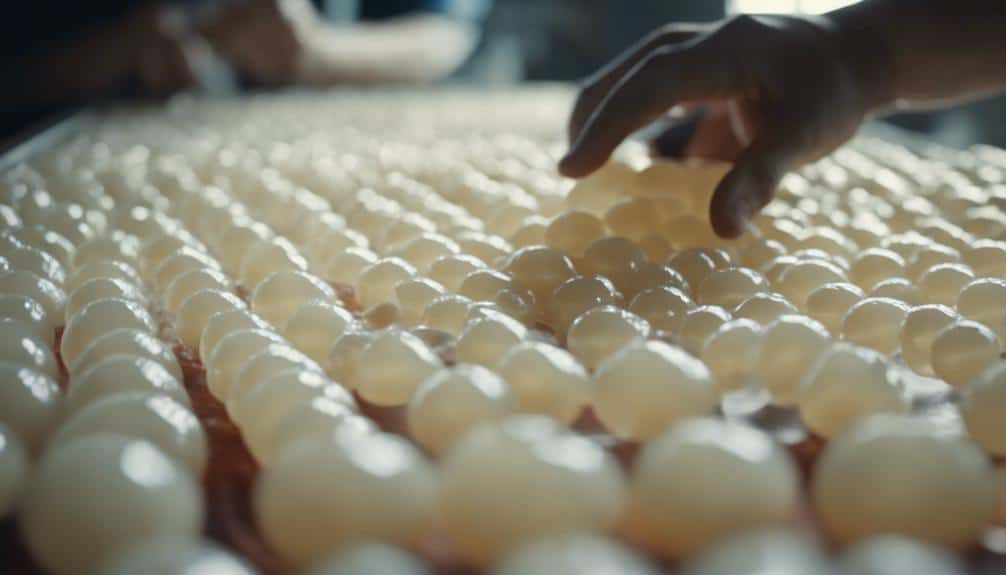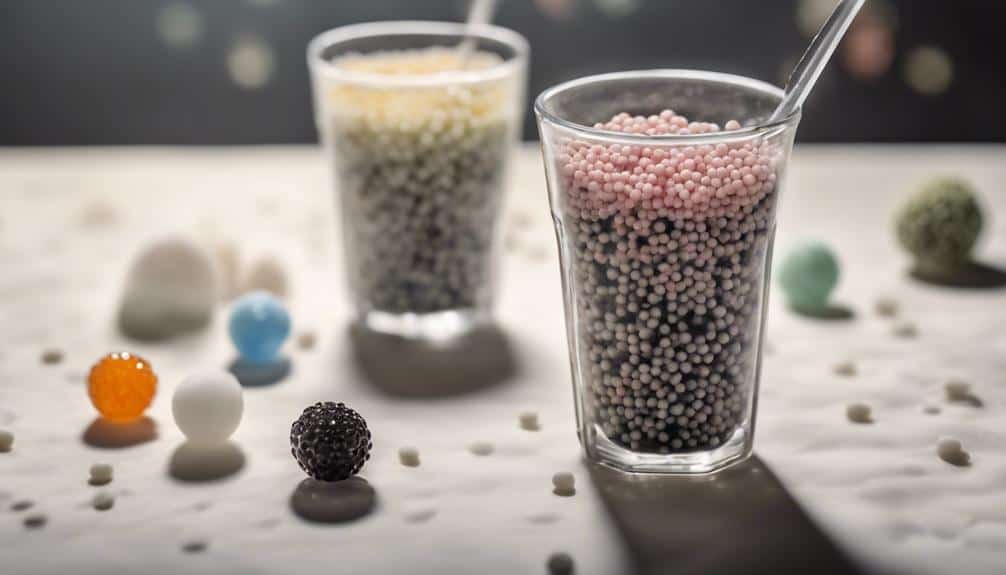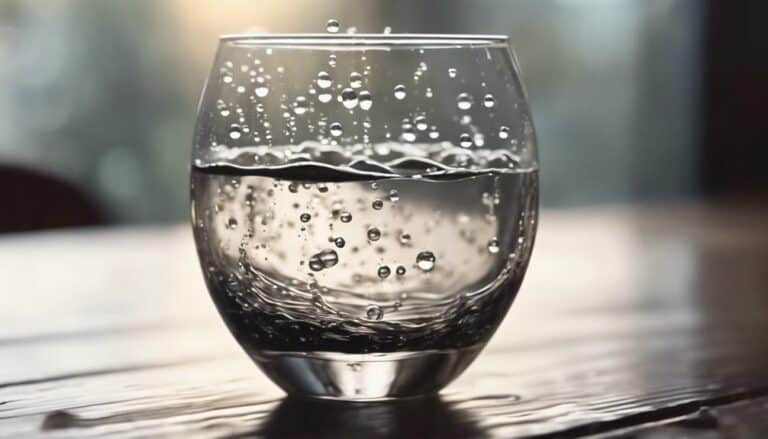What Are Boba Balls Made Of?

So, have you ever wondered about the mystery behind what exactly boba balls are made of? Well, the answer might surprise you. These chewy spheres have a unique composition that goes beyond just tapioca starch. The process of creating these beloved boba pearls involves a delicate balance of ingredients and techniques that contribute to their distinct texture and flavor profile. Let's unravel the secrets behind the creation of these delightful toppings that have taken the culinary world by storm.
Origin of Boba Balls
Boba balls, originating in Taiwan in the 1980s, revolutionized the bubble tea industry with their unique tapioca starch composition. These chewy pearls, made from tapioca starch derived from cassava root, are a hallmark of bubble tea drinks. The process of creating these boba pearls involves shaping tapioca starch into small spheres that are boiled to achieve their distinctive texture.
In Taiwan, where black tea is commonly used as the base for bubble tea, boba balls are boiled with brown sugar to infuse them with a rich sweetness that complements the tea's robust flavor. This traditional method of preparation has become a standard in bubble tea establishments worldwide, ensuring a consistent and authentic boba tea experience.
The introduction of boba balls hasn't only elevated the bubble tea industry but has also sparked creativity in flavor combinations. From fruit-infused boba to colored pearls, the versatility of boba balls continues to drive innovation in the beverage industry, offering consumers a wide array of choices to suit their tastes.
Ingredients in Boba Balls
Derived from the cassava root, the main ingredients in boba balls consist of tapioca starch that undergoes a process involving shaping, boiling with brown sugar, and cooking for approximately 30 minutes. This essential cooking time is pivotal in achieving the desired chewy texture of boba balls.
The tapioca starch is carefully mixed with water to form a dough, which is then rolled into small spheres to give boba balls their characteristic spherical shape. The addition of brown sugar during boiling not only sweetens the boba balls but also imparts a slight caramel flavor to enhance the overall taste.
Moreover, to introduce exciting variations, some boba shops incorporate fruit puree or syrup into the tapioca balls. This infusion of fruity flavors adds a delightful twist to the traditional boba experience, catering to a broader range of taste preferences.
Whether enjoyed plain or with fruity enhancements, the fundamental ingredients of tapioca starch and cassava root remain constant, ensuring that boba balls retain their essence while offering diverse and innovative options for boba enthusiasts.
Vegan Options for Boba Balls

Vegan boba balls are crafted from plant-based ingredients, steering clear of animal products such as gelatin or honey. Tapioca pearls, the core component of boba balls, are inherently vegan, making them a suitable choice for those following a plant-based diet.
The cooking process often involves simmering these pearls in solutions like brown sugar syrup or fruit juices to infuse them with delightful flavors.
Vegan Boba Ingredients
Crafted from tapioca starch, cassava root, water, and natural sweeteners, the ingredients used in vegan boba balls guarantee a plant-based and gelatin-free composition. These plant-based alternatives are a staple in bubble tea shops, offering ethical choices for those seeking cruelty-free options.
Tapioca starch, derived from the cassava root, serves as the main ingredient, providing the chewy texture characteristic of boba balls. Mixed with water and sweetened naturally, these ingredients create a delightful treat suitable for vegans.
Plant-Based Alternatives
Utilizing agar agar as a key ingredient, plant-based alternatives for boba balls offer a cruelty-free and sustainable choice for consumers seeking vegan options.
Agar agar, derived from seaweed, serves as a vegan-friendly gelling agent, replacing traditional gelatin in boba production. This plant-based substitute guarantees that boba balls maintain their desired texture without the need for any animal-derived components.
By opting for vegan boba balls, individuals adhering to a plant-based diet can indulge in this popular treat guilt-free. The use of agar agar not only caters to the vegan community but also promotes ethical practices by offering a cruelty-free option.
Embracing plant-based alternatives in boba production aligns with sustainability efforts and provides a satisfying experience for all boba enthusiasts.
Making Process of Boba Balls
To create boba balls, tapioca starch sourced from the cassava root is meticulously shaped into small spheres before being boiled with brown sugar to infuse them with a sweet flavor. This process gives the boba balls their signature chewy texture and delicious taste.
For fruit boba variations, specialty shops incorporate fruit puree or syrup into the tapioca balls, adding a burst of fruity goodness to the experience.
While large chains often opt for convenience by using uncooked tapioca balls, some artisanal shops take pride in making boba from scratch, ensuring quality and authenticity.
Instant tapioca pearls are also available for home use, allowing enthusiasts to enjoy boba drinks without the need for extensive preparation. Understanding the meticulous making process behind boba balls sheds light on the craftsmanship and creativity involved in producing these delightful treats.
Boba Balls Production Methods

In the production of boba balls, tapioca starch from the cassava root undergoes a meticulous process involving shaping, boiling with brown sugar, and cooking for approximately 30 minutes. This method guarantees that the tapioca starch forms into the iconic chewy pearls that are a staple in bubble tea drinks.
While some larger chains opt for pre-made tapioca balls that require cooking, smaller shops often choose to make them from scratch to maintain quality and authenticity.
To add a burst of flavor, variations like strawberry boba or mango boba are created by infusing the tapioca balls with fruit puree or syrup during the cooking process.
For those who prefer to enjoy boba at home, instant tapioca pearls are available for convenient preparation.
Understanding the detailed production methods behind boba balls allows for a greater appreciation of the effort and skill that goes into creating these delightful treats.
Availability of Boba Balls
Boba balls are readily available through various sources, including online platforms, chain stores, and local bubble tea cafes. These tapioca pearls come in a variety of flavors, colors, and sizes, catering to different preferences and recipes.
Whether one opts for ready-made boba balls or chooses to craft them at home using DIY kits, the accessibility and diversity of boba balls contribute to their popularity in the bubble tea industry.
Boba Ball Sources
Conveniently accessible through online orders, chain stores like Walmart, and local bubble tea cafes, boba balls are a versatile topping option that enhances the bubble tea experience with their unique flavor and texture.
Tapioca balls, also known as boba pearls, play a vital role in the creation of bubble tea. For those interested in a hands-on approach, DIY guides are available for making tapioca balls from scratch, allowing for a personalized touch to the boba experience.
Pearly kits offer a convenient solution for individuals looking to make bubble tea at home, providing all the necessary ingredients, including boba balls.
Whether purchased from chain stores, online stores, or enjoyed at bubble tea cafes, boba balls remain a sought-after ingredient for bubble tea enthusiasts seeking a delightful and customizable beverage addition.
Boba Ball Varieties
Varieties of boba balls present diverse options for enhancing the bubble tea experience, catering to different preferences and tastes. Tapioca balls, also known as boba pearls, come in various forms, including those made from scratch using tapioca flour. These boba balls can be found in different colors such as green or black, each offering a unique texture and flavor profile.
Some boba pearls even come infused with fruity flavors, adding an extra dimension to the traditional bubble tea. DIY enthusiasts can experiment with making their own boba pearls at home, using kits that provide all the necessary ingredients.
Whether purchased online, at chain stores like Walmart, or sourced from local bubble tea cafes, boba balls remain an essential element in the bubble tea experience.
Nutritional Facts of Boba Balls

In a single cup of tapioca pearls, there are approximately 544 calories, primarily derived from tapioca starch sourced from the cassava root. The cooking process involves boiling boba balls with brown sugar, adding a sweet flavor to the chewy pearls. Varieties like strawberry boba or mango boba are made by infusing fruit puree or syrup into the tapioca balls. The nutritional facts of boba balls can vary depending on the specific ingredients used in their preparation. Below is a table highlighting the approximate nutritional content of a standard serving of boba balls:
| Nutrient | Amount Per Serving |
|---|---|
| Calories | 544 |
| Total Fat | 0g |
| Sodium | 3mg |
| Total Carbohydrate | 135g |
| Protein | 0g |
These figures provide insight into the caloric intake and macronutrient composition of boba balls, offering a clearer understanding of their nutritional profile.
Conclusion
To sum up, boba balls are primarily made from tapioca starch derived from the cassava root. The process involves shaping the starch into small spheres that are boiled with brown sugar for added sweetness.
These chewy balls can be infused with various flavors and colors, making them a versatile ingredient for bubble tea and desserts.
Whether made from scratch or using instant pearls, boba balls offer a unique and enjoyable culinary experience.





